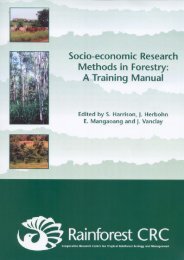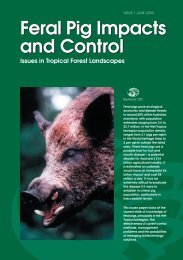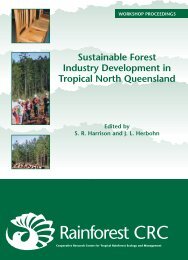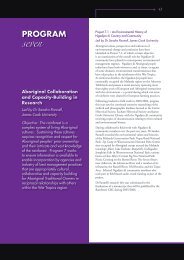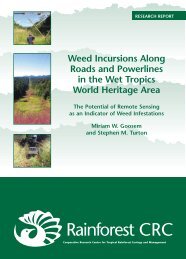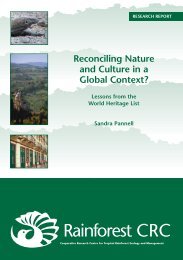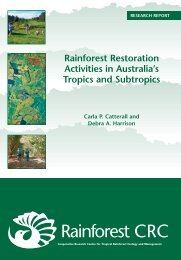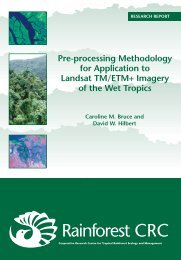Reconciling Nature and Culture in a Global Context? - Rainforest ...
Reconciling Nature and Culture in a Global Context? - Rainforest ...
Reconciling Nature and Culture in a Global Context? - Rainforest ...
Create successful ePaper yourself
Turn your PDF publications into a flip-book with our unique Google optimized e-Paper software.
S<strong>and</strong>ra Pannellfrom the shopp<strong>in</strong>g <strong>and</strong> bustle of Hong Kong, or an opportunity to gamble <strong>in</strong> the many cas<strong>in</strong>oswhich flank the city. Surrounded by high-rise build<strong>in</strong>gs, non-descript concrete blocks, <strong>and</strong>flashy hotel complexes, the Historic Centre of Macau “provides a unique testimony to themeet<strong>in</strong>g of aesthetic, cultural, architectural <strong>and</strong> technological <strong>in</strong>fluences from East <strong>and</strong> West”(UNESCO World Heritage Centre website 2005). In an acknowledgement of its strategicimportance <strong>in</strong> the development of <strong>in</strong>ternational trade, the Historic Centre of Macau isidentified as a cultural heritage property of ‘outst<strong>and</strong><strong>in</strong>g universal value accord<strong>in</strong>g to four ofthe Convention’s ten criteria. Inscribed as a location which favoured; (1) “an important<strong>in</strong>terchange of human values” (criterion ii), (2) bears a unique testimony to the ‘earliest’ <strong>and</strong>‘longest-last<strong>in</strong>g’ encounter between Ch<strong>in</strong>a <strong>and</strong> a European colonial power, <strong>in</strong> this casePortugal (criterion iii), <strong>and</strong> (3) represents an outst<strong>and</strong><strong>in</strong>g example of architectural ensemblel<strong>in</strong>k<strong>in</strong>g the orig<strong>in</strong>al Ch<strong>in</strong>ese port with the Portuguese city (criterion iv), the Historic Centre ofMacau is also recognised <strong>in</strong> terms of its “association with the exchange of a variety ofcultural, spiritual, scientific <strong>and</strong> technical <strong>in</strong>fluences between Western <strong>and</strong> Ch<strong>in</strong>esecivilisations” (criterion vi) (ICOMOS 2005a: 61-62).The ICOMOS evaluation of the site reiterates the history of the development of the HistoricCentre of Macau presented <strong>in</strong> the orig<strong>in</strong>al nom<strong>in</strong>ation document (ICOMOS 2005a).Accord<strong>in</strong>g to this document, the site of Macau was a fish<strong>in</strong>g village long before the arrival ofthe Portuguese <strong>in</strong> 1557. The name of Macau derives from the Ma Kwok temple, built <strong>in</strong> thefourteenth century. This temple, together with the fifteenth century temple for the GoddessA-Ma, comprised two of the more prom<strong>in</strong>ent architectural forms that existed among the smallsettlements of seafar<strong>in</strong>g merchants, fishermen <strong>and</strong> farmers, prior to the arrival of thePortuguese. The early Portuguese settlers, look<strong>in</strong>g to establish Macau as a ‘bastion ofChristianity’, as well as a trad<strong>in</strong>g post, erected timber <strong>and</strong> clay houses <strong>in</strong> the Inner Harbourarea of Macau. While none of the orig<strong>in</strong>al dwell<strong>in</strong>gs survive today, some of the Catholicchurches <strong>and</strong> chapels established <strong>in</strong> the early colonial period (the 1500s <strong>and</strong> 1600s) formpart of the Historic Centre of Macau. In the early seventeenth century the Portugueseconstructed a series of forts aga<strong>in</strong>st other Western powers, notably the Dutch, who attackedMacau <strong>in</strong> 1622 (Boxer 1969: 111). One of the surviv<strong>in</strong>g forts from this period, the MountFortress (constructed <strong>in</strong> 1626), is enclosed with<strong>in</strong> the central area of the historic settlement ofMacau. In the mid-seventeenth century, the settlement of Macau was divided <strong>in</strong>to aPortuguese sector <strong>in</strong> the south <strong>and</strong> a Ch<strong>in</strong>ese enclave <strong>in</strong> the north. In 1849, Portugaldeclared Macau a ‘free port’, enhanc<strong>in</strong>g Macau’s role as a trad<strong>in</strong>g base <strong>and</strong> attract<strong>in</strong>g foreigncompanies to the enclave. In the late eighteenth <strong>and</strong> n<strong>in</strong>eteenth centuries, the CatholicChurch built a number of new churches <strong>and</strong> restored some of the earlier ones. It wastowards the end of the n<strong>in</strong>eteenth century that Macau, unable to compete with Hong Kong asthe region’s f<strong>in</strong>ance <strong>and</strong> trade centre, became a popular recreation dest<strong>in</strong>ation for foreigners.Some of the build<strong>in</strong>gs constructed at this time, such as the Dom Pedro V Theatre, theMilitary Club, <strong>and</strong> the Vela Vista Hotel, are listed as part of the architectural ensemble ofhistoric Macau. Apparently, dur<strong>in</strong>g this time the Ch<strong>in</strong>ese built a number of temples (also<strong>in</strong>cluded with<strong>in</strong> the World Heritage area) <strong>and</strong> started the process of l<strong>and</strong> reclamation. In1974, Macau was established as a ‘Ch<strong>in</strong>ese territory’ under Portuguese adm<strong>in</strong>istration, <strong>and</strong>later <strong>in</strong> 1999, it became a ‘Special Adm<strong>in</strong>istrative Region’ (SAR) under Ch<strong>in</strong>ese Sovereignty(ICOMOS 2005a).The World Heritage property consists of two separate ‘core zones’, with buffer zonessurround<strong>in</strong>g each of these areas (Map 4). The boundaries of these buffer zones areidentified as co<strong>in</strong>cid<strong>in</strong>g with the early n<strong>in</strong>eteenth century limits of the territory of Macau.While these ‘buffer zones’ may play an important role <strong>in</strong> separat<strong>in</strong>g the Historic Centre ofMacau from encroach<strong>in</strong>g development, they are not <strong>in</strong>cluded with<strong>in</strong> the boundaries of thelisted World Heritage property. A series of architectural forms <strong>and</strong> urban spaces, <strong>in</strong>clud<strong>in</strong>gsquares, churches, chapels, temples, a fort, a lighthouse, gardens, cemetery, ru<strong>in</strong>s, oldwalls, colonial government build<strong>in</strong>gs <strong>and</strong> residences comprise the World Heritage focus ofthe two core zones (Figure 15). The heritage build<strong>in</strong>gs with<strong>in</strong> these zones, <strong>in</strong>clud<strong>in</strong>g three52




